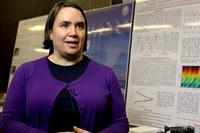“Because the circulation has slowed, the old air with higher amounts of HCI is taking longer to move through the stratosphere,” said Walker. “CFCs produced before the UN Montreal Protocol ban was in place, as well as ozone-destroying substances that were phased out over the past two decades, are still in the atmosphere and causing damage.”
CFCs are responsible for the depletion of the ozone layer that protects Earth from ultraviolet radiation. They break up in the stratosphere and release chlorine atoms that then form HCl, the major chlorine reservoir in the Earth's upper atmosphere.
It is this chlorine that thins the ozone layer over the globe and causes the springtime holes in the ozone layer over Antarctica.
According to Walker, the SCISAT instrument provided the reliable hydrogen chloride measurements in the lower stratosphere that were essential to solve the mystery.The satellite was launched in 2003 to study ozone and molecules involved in ozone production and destruction. Its measurements contribute to improving our understanding of atmospheric chemistry and air quality over Canada and the Arctic, including air pollution caused by forest fires.
The study, co-authored by Walker, appeared in Nature on November 6.
Link: http://news.utoronto.ca/solving-mystery-increased-hydrogen-chloride-northern-hemisphere

